Bari is once again confronting its oldest history thanks to the intervention of artist Edoardo Tresoldi (Milan, 1987), who presented to the public the scale model of the monumental installation that will take shape in thearchaeological area of San Pietro, in the heart of the old town. On Thursday, July 3, the church of San Francesco della Scarpa was filled with citizens, institutional representatives, students and young people from the neighborhood who flocked to get a preview of the project that promises to transform not only the image of the old town and also the urban skyline.
The initiative stems from an international call for bids issued by the Regional Secretariat of the Ministry of Culture - Apulia, directed by architect Maria Piccarreta, and is part of a wide-ranging project to enhance the area, which has been the subject of archaeological excavations and studies for decades. The presentation turned into a community party, accompanied by the music of the Swing 31 and the parade of timpanists from the Nicolaus Barium association, a symbol of a past that returns to resonate among the stones of the old city. It was also made possible thanks to the support of COBAR spa, the company executing the project.
Tresoldi’s work is intended to be an architectural reflection on time and memory. The model presented represents the embryo of an unprecedented intervention, developed over the course of four years and inspired by the famous installation the artist created in 2016 in Siponto. Once again, the metal mesh and the play of transparencies are tools through which Tresoldi redesigns the identity of the place, evoking what has disappeared and reinterpreting what remains.
San Pietro, the point of origin of the city of Bari, has been for centuries a crossroads of transformations, architectural metamorphoses and changes of destination. The artist’s work visually restores the temporal stratification of the area, representing the buildings that have succeeded one another on the site in a game of volumetric interlocking: architectures enclosed within one another, in a spatial narrative that aims to reveal the heterogeneity of the urban heritage, but also the personal and collective heritage of an entire community.
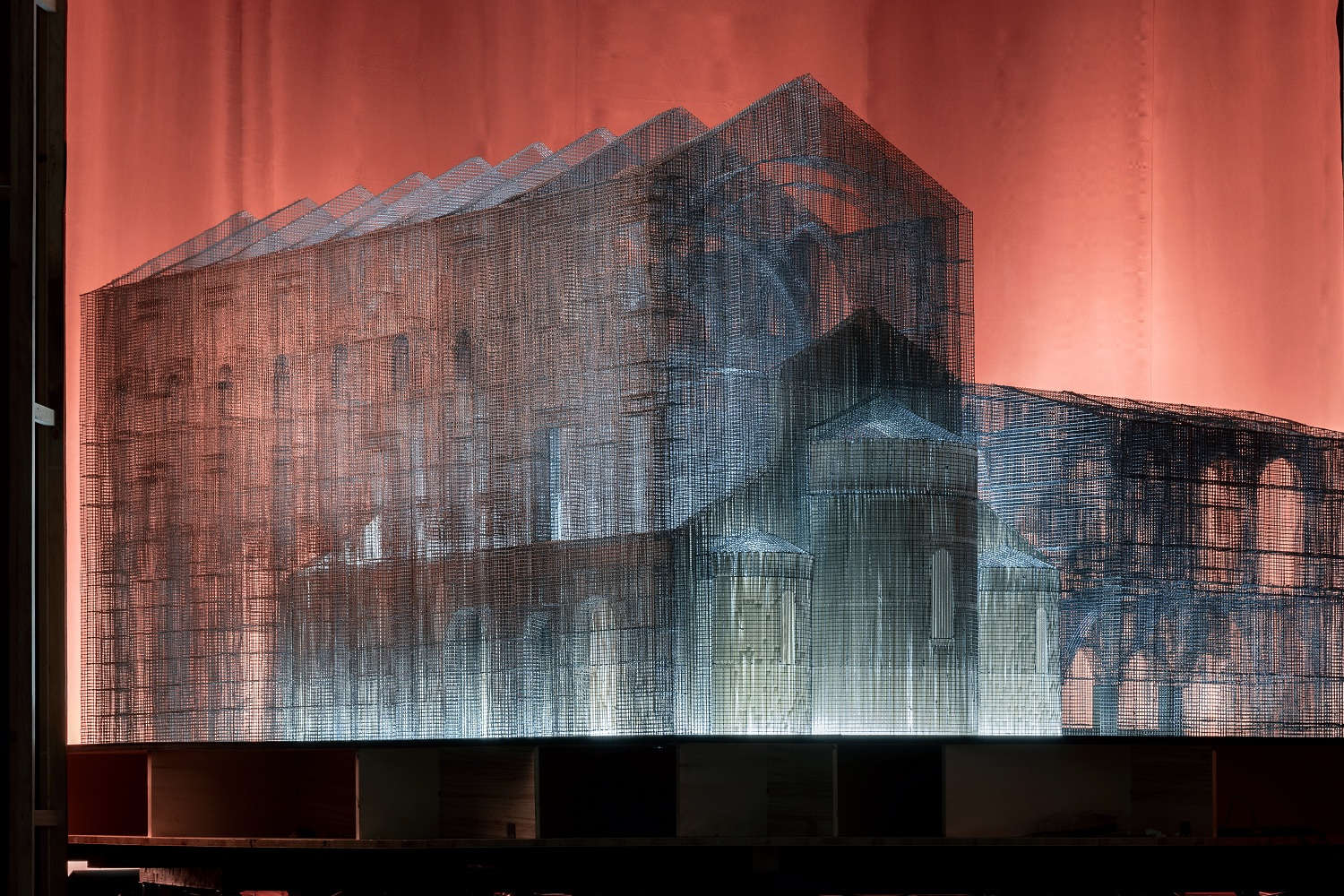
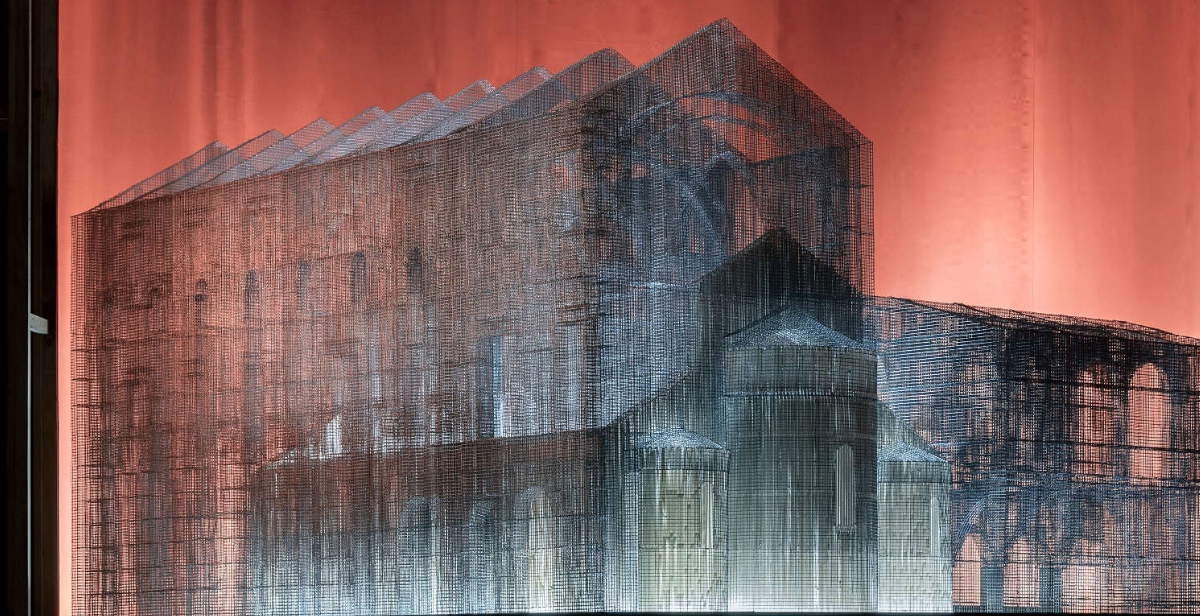
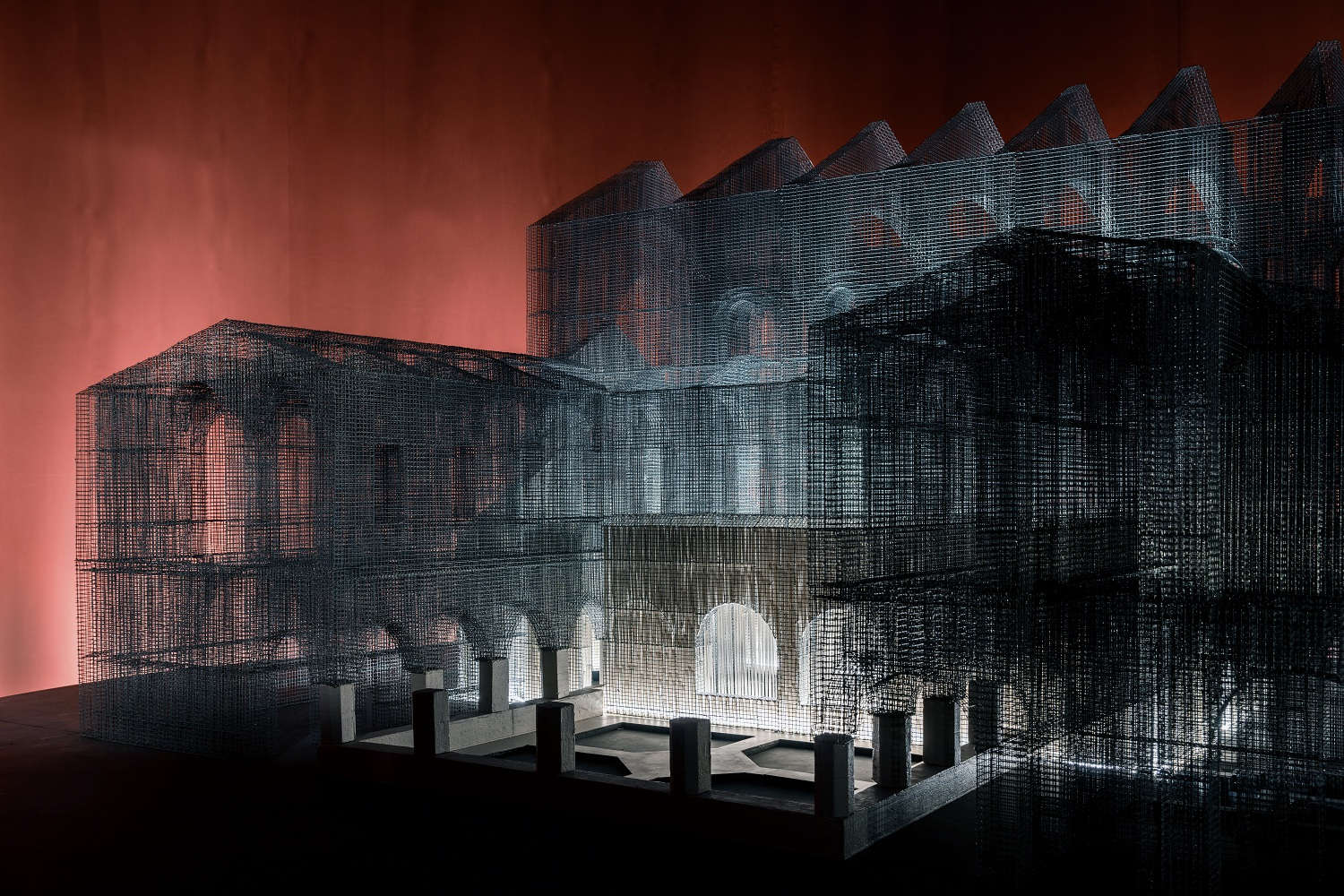
The project stands as an act of refoundation. Tresoldi reflects on the significance of reconstruction as a contemporary gesture capable of rewriting the identity of a place and redefining its function in the present. Thus St. Peter’s, with its past linked to worship and care - first a church, then a convent, finally a hospital - is proposed as a symbol of rebirth and dialogue between the sacred and the human. The artist asks questions about the meaning of the temple and the need for sacredness in modern cities, resulting in a new building that is both ancient and current.
The installation is rooted in the matter of the city. The walls of the oldest church will be made with aggregates and waste materials from the demolition of contemporary buildings in Bari. A choice that recalls the material memory of the city, reinserting it into a new life cycle and transforming the remains of the modern into poetic and constructive elements. A gesture intended to allow collective memory to find new readings and interpretations in urban space, making it operational, alive and capable of welcoming new stories.
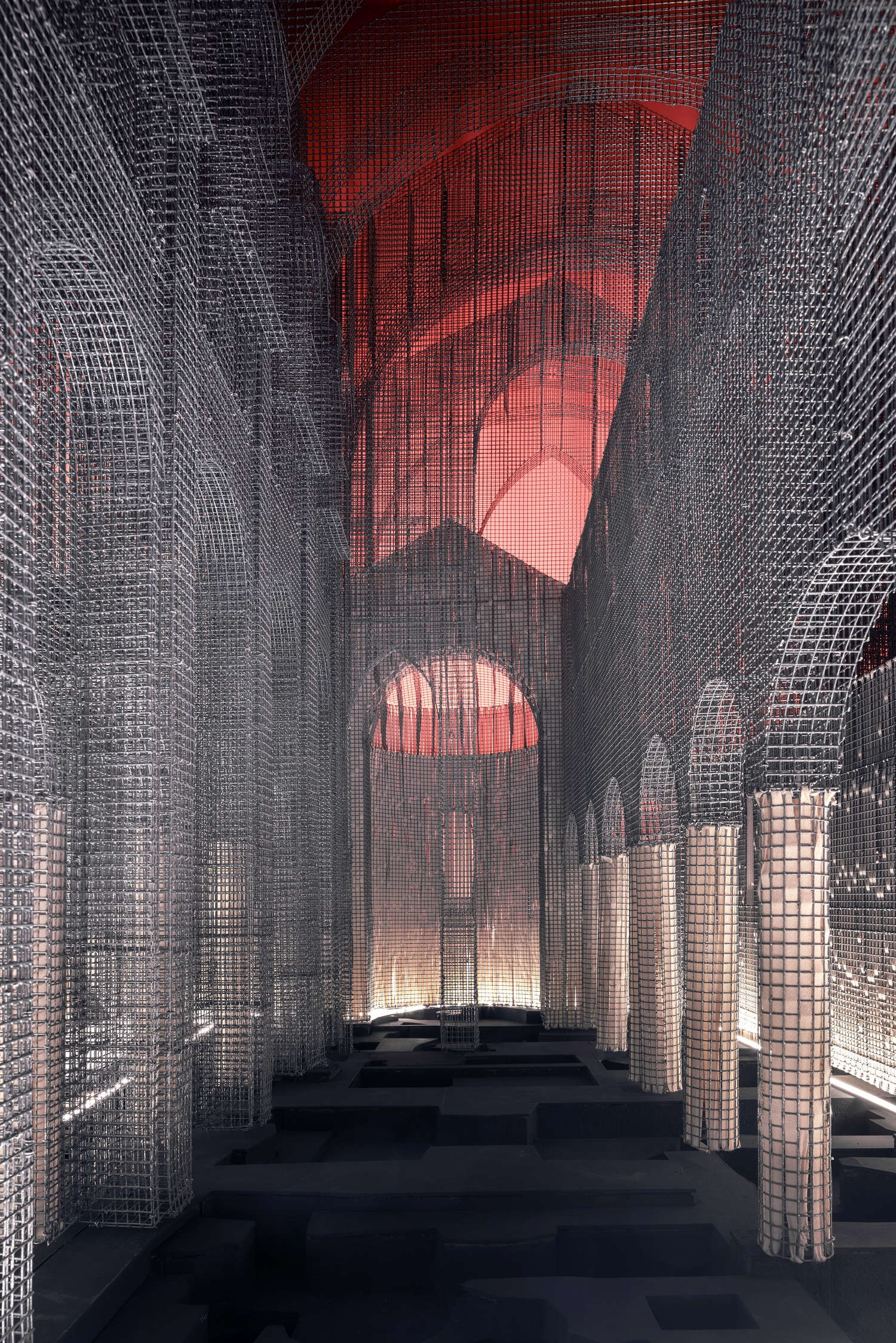


Since the early twentieth century, the site of San Pietro has been the subject of a long series of excavation campaigns conducted by the Ministry of Culture. Thanks to these studies, today it is known that the subsoil of the area preserves an uninterrupted stratification of almost four thousand years of history, starting from the Bronze Age until the 1960s. A unique testimony to settlement and cultural continuity in the heart of Bari.
The latest excavation campaign, completed in May 2024, provided additional data useful for the reconstruction, which will take place not as a mere architectural replica, but as an artistic interpretation in dialogue with history. Tresoldi’s installation is thus conceived as a visual and poetic synthesis of the forms that have characterized the site over the centuries, from the Middle Ages to the 19th-century transformation into a civilian building, used as a hospital until its demolition in 1969. The complexity of the intervention at St. Peter’s is greater than at Siponto, precisely because of the multiplicity of historical phases the site has gone through. Over the centuries, the area has seen the presence of an early medieval church, transformed in the Romanesque period between the 11th and 12th centuries, later remodeled in the 15th century with the construction of the Franciscan convent and further expanded in the 17th century. In the nineteenth century, the entire complex was put to civilian use, culminating in the function of the Consortial Hospital, then severely damaged by bombing in 1943 and the explosion of the steamer Charles Henderson in 1945.
The building was finally abandoned and demolished in 1969, but the memory of the place has remained alive in the consciousness of the residents of old Bari. The hospital, as well as the religious structures that had preceded it, live on in oral tales, legends, and anecdotes passed down between generations. An intangible heritage that fueled the artist’s inspiration, prompting him to question the deep meaning of that site for the city and its people.
Tresoldi’s work is the result of an in-depth study not only of archaeological sources, but also of community memories. The artist analyzed surveys, maps, excavation reports, archival documents and oral testimonies, coming to the realization that at the center of the site the echo of the church of St. Peter still survives in the toponymy and in the city’s imagination. Thus, through his art made of transparencies and suggestions, Tresoldi intends to restore form and soul to a place that has been suspended for too long. The installation will not merely recall the past, but will seek to be a living space, a new urban temple that reflects on the very concept of time, transformation and memory. A meeting point between what has been and what still can be, in the beating heart of Bari.



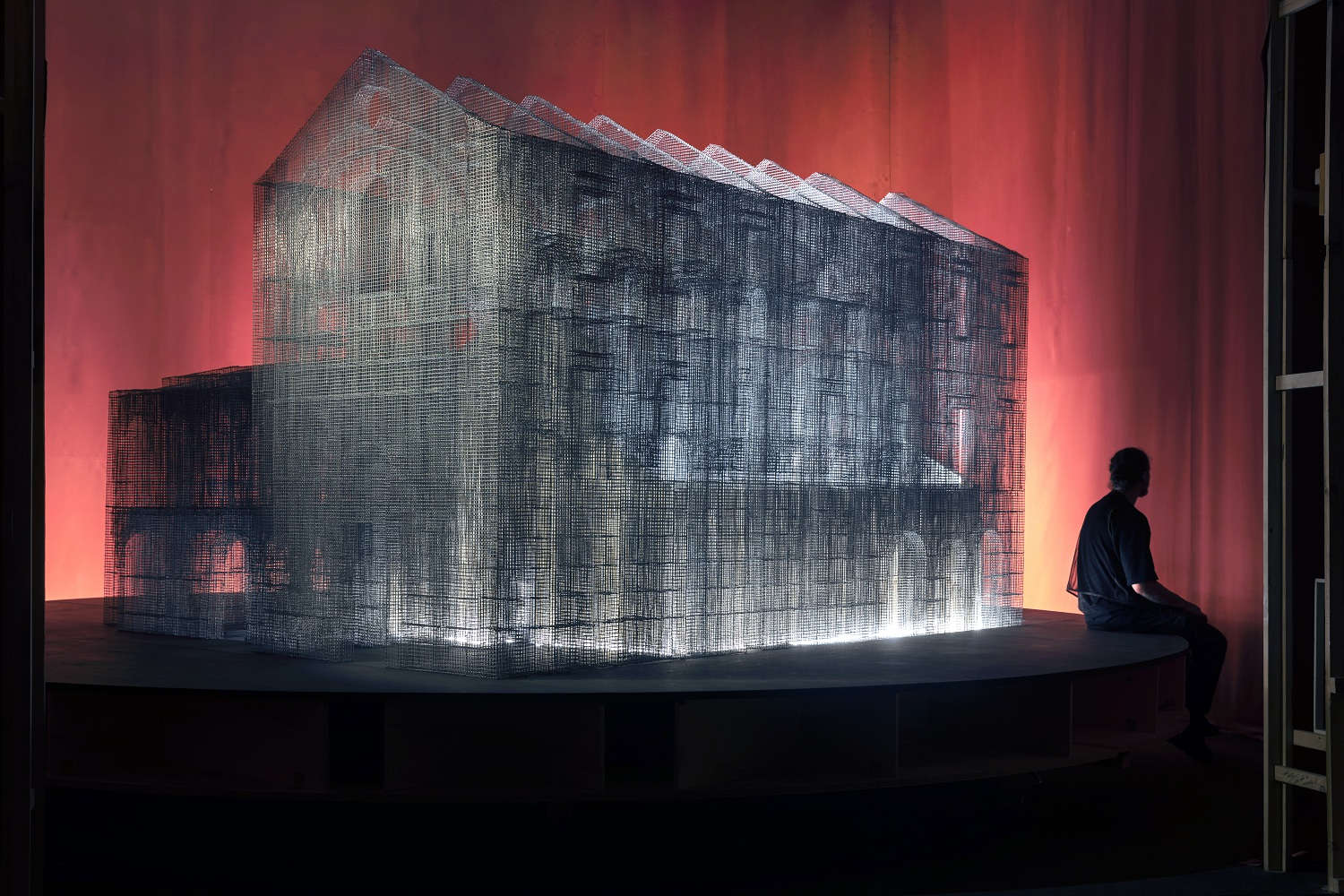
“San Pietro, in Bari, is an ancient place that has never stopped transforming, it is a fragment of the city that through time has known different forms of life, of thought, of the sacred,” explained Edoardo Tresoldi. “Here matter has been made and unmade several times; each time a passage, a mutation. Each time, a human gesture that has left a mark. All these changes tell precisely the evolution of the city and the way people have lived and thought about this place. Building, destroying, rebuilding -- like a breath. Layers upon layers rooted in the same handkerchief of earth that, through the centuries, in different forms, has been a house of worship, a place of rituals, a guardian of the sense of the sacred according to the city and its inhabitants. Building St. Peter’s is an act that returns and in some way asks us: who are we? What do we value? What is the sense of the sacred for us? As an artist I try to shape a vision, to evoke a presence that we can all recognize even though we have never seen it. This place, and the sculpture that this place will house, will be a dialogue between what we have been and what we are now.”
“The long reflection that involved the interdisciplinary design team on the objectives and adoptable methods of proposing the site to the public focused in particular on the theme of reintegrating the image in archaeological areas without elevations,” says architect Francesco Longobardi, Project Designer and Director of Works for the St. Peter’s Archaeological Area Enhancement Project. “Thus was born the idea of allowing a volumetric reading of the best-preserved buildings in the foundation, projecting their perimeters brought to light by the archaeological investigations in elevation. And, in order to do so, the choice was made to rely on the poetic language of contemporary art, stipulating that the installation be designed and realized in such a way as to meet the requirements of scientific rigor and consistency with the principles of restoration, as well as effective communication aimed at the general public. The complex reflection that involved the interdisciplinary design team on the objectives and adoptable methods for proposing the site to the public focused in particular on the issue of reintegrating the image in archaeological areas without elevations. This gave rise to the idea of allowing a volumetric reading of the best-preserved buildings by projecting in three dimensions their perimeters brought to light by archaeological investigations. To do this, the choice was made to rely on the poetic language of contemporary art, stipulating that the installation be designed and built to meet the requirements of scientific rigor and consistency with the principles of restoration, as well as effective communication aimed at the general public. The adjudication to Edoardo Tresoldi is making it possible, more than ten years after the successful intervention we carried out together in Siponto, to put to good use what came out of the outcomes of that operation. Strengthened by the experience gained and aware of the differences between the site of Siponto and that of Bari, whose subsoil encloses not one but multiple historical phases to be brought to value, we are carrying out an operation that is also one of urban regeneration, in which the attention to every detail and theosmosis between different instances and methods of approach, strongly pursued, we hope will bring us as close as possible to the goal of handing back to the community all the values contained in a place that is both space and time, remote past and near future.”
“What is being born will be the largest contemporary artwork ever created in Bari. It will rise on the oldest archaeological area of the city, an urban space that for years has been waiting for a new identity and that today is transformed into something extraordinary,” commented Bari Mayor Vito Leccese. “With its 30-meter height, beginning to take shape, profiles and silhouettes in transparency designed by Tresoldi, it will tell the story of this place with games of lines and lights that we will all be able to walk through and admire. A contemporary work capable of opening new scenarios for the conservation and enhancement of historical and archaeological heritage, in which light-in the city of light-plays a decisive role in the presence-absence relationship. This installation will project Bari on the national and international scene, giving the city a new narrative, capable of combining its millenary roots with a contemporary vision. In short, a bridge, a journey between past and future.”
 |
| Bari, Edoardo Tresoldi will make a large wire mesh installation: here is the model |
Warning: the translation into English of the original Italian article was created using automatic tools. We undertake to review all articles, but we do not guarantee the total absence of inaccuracies in the translation due to the program. You can find the original by clicking on the ITA button. If you find any mistake,please contact us.